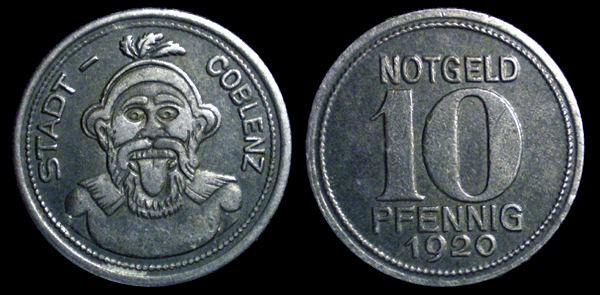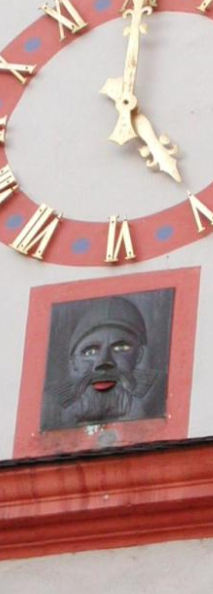
STADT COBLENZ (GERMAN) 10 PFENNIG 1920
F- 80.3 City of Coblenz (German) 10 Pfennig Notgeld Coin Depicting the Augenroller (Eye Roller).
|
Coblenz (Koblenz) is an historic city situated on the banks of the Rhine where it meets the Moselle river. Although settlements have been in this area since at least 1000 B.C. and Julius Caesar visited around 55 B.C., It was first established as a military post by Nero Claudius Drusus Germanicus (Drusus) as "Castellum apud Confluentes", around 8 B.C., it derives its name from the Latin Confluentes (confluence) or 'merging of two rivers'. Modern Koblenz it is the third largest city in Rhineland-Palatinate (one of the 16 federal German states). Through its long history it has changed hands many times having been held mainly by Prussia or Germany but also briefly by Russia as well as France which occupied the the city several times, the last being after World War I. Like many cities it was severely damage during World War II and has undergone extensive post war reconstruction. Modern Koblenz has a population slightly over 100,000 and is known for it beautiful buildings, its theatres, a museum of antiquities, as well as a conservatory of music. It is a principal seat of the Mosel and Rhenish wine trade and also does a large business in the export of mineral waters. It is home to many manufacturing concerns which make automotive parts, pianos, paper, cardboard, machinery, boats and barges. Its situation on two rivers also makes it an important transit centre. The city is the home of the Deutsches Eck (German Corner) and its monument featuring the equestrian statue of the Emperor Wilhelm I. The Augenroller: This coin depicts the Augenroller (Eye Roller) which is a relief of a mans face that can be found on the clock tower of a gothic building in the old historical section of Koblenz. Its eyes move back and forth ticking off the seconds and every hour and half hour its tongue will protrude from its mouth. The Augenroller depicts the knight Johann Lutter of Koburn who was accused of being a bandit. He was captured and after prolonged torture he is said to have confessed to his crimes and was sentenced to be beheaded on October 14, 1536. It is said that as he was led to the site of his execution he exclaimed in a loud voice 'Establish a monument to me and it will bring you luck!'. While on the platform he is said to have rolled his eyes and stretched out his tongue for the spectators and once his head lay severed it continued to roll its eyes and flap its tongue. This was taken as a sign from god so the citizens established the Augenroller monument. The original Augenroller was destroyed during the second World War but a new one was erected and can be seen today under the clock on the tower of the beautiful gothic Mittelrhein Museum. |

